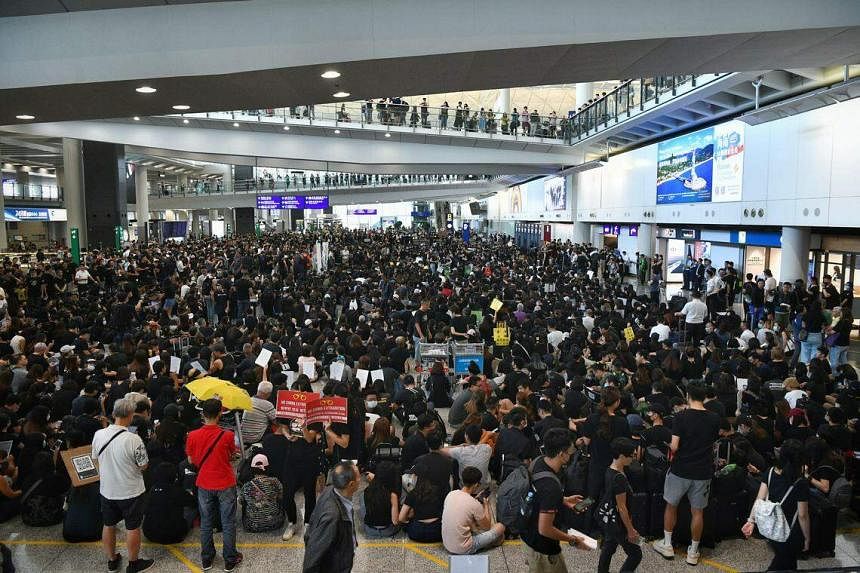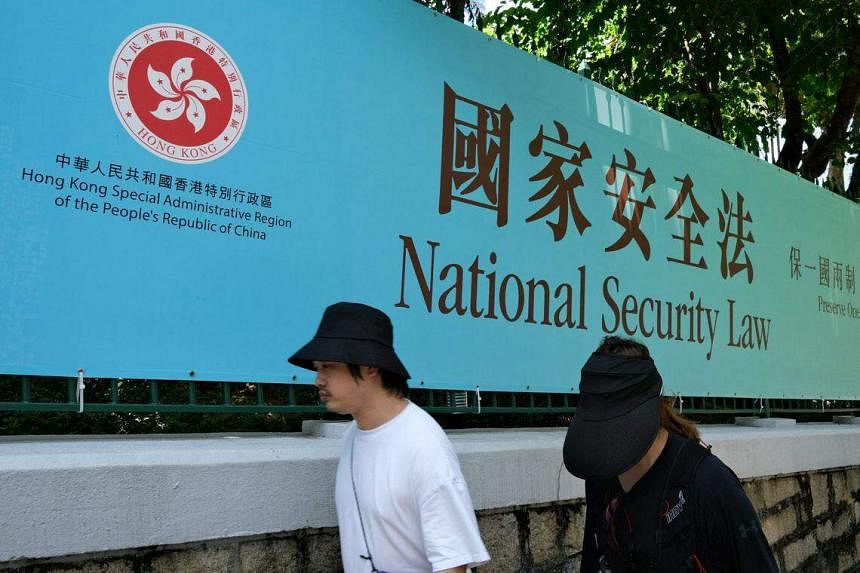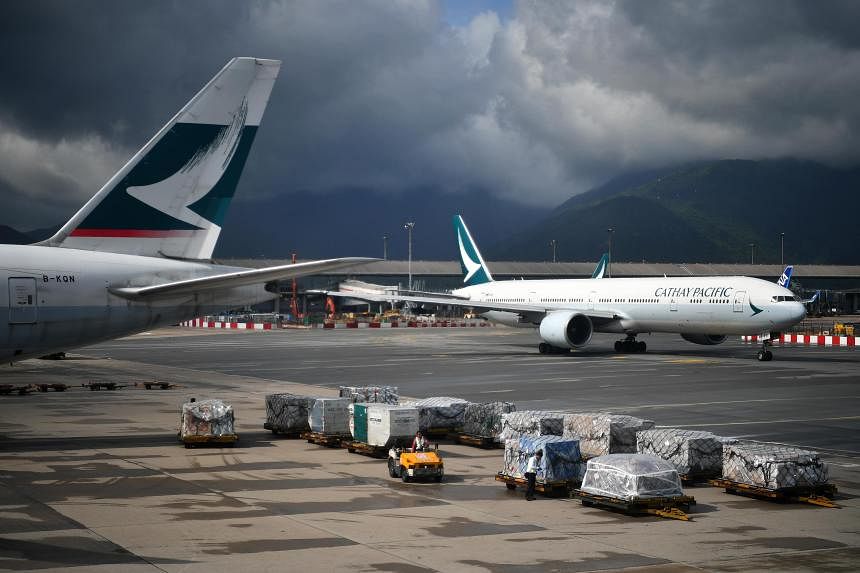HONG KONG - To understand how Hong Kong has evolved in recent years, one needs to look no further than to one of the city’s biggest brand names, Cathay Pacific.
The trials and tribulations at Hong Kong’s flagship airline over the past several years have directly traced significant events and reflected major turning points in the city’s recent history. The carrier’s current efforts to inject new life into its business find echoes in the broader efforts to revitalise the city.
While its official function is that of a commercial airline, Cathay Pacific’s fortunes have tended to parallel Hong Kong’s because it is in many ways a microcosm of Hong Kong society; as such it could be seen as a good gauge, if not an exact proxy, of how the city is faring and how its future will unfold.
Consider its DNA, which reflects Hong Kong’s colonial past: Swire Group – owned by London-based John Swire & Sons – holds a 45 per cent stake in the carrier while China’s state-run Air China owns nearly 30 per cent.
Just as Hong Kongers have harboured longstanding fears of Beijing’s eventual “mainlandisation” of their home city, local investors have similarly long speculated about a potential Air China takeover of the Hong Kong carrier.
Chaos rocks the city – and its airport
It was against this historical backdrop of latent anxiety that an unprecedented scale of anti-government protests broke out across Hong Kong in the summer of 2019.
And Cathay Pacific soon became the most visible corporate victim of that political unrest.
The demonstrations, which started on June 9 that year, were triggered by the government’s push for an extradition Bill that would have allowed for criminal suspects to be transferred to mainland China to face trial.
The massive, often violent, protests had been raging for two months when demonstrators decided to stage a sit-in at the airport. For five straight days, airport operations were crippled and more than 300 flights cancelled.

Some Cathay employees openly took sides, with one pilot broadcasting remarks supporting the airport sit-in to passengers during a flight.
Initially, Cathay said it would not stop staff from doing so, but it made an abrupt U-turn a week later, after a furious backlash from China that saw the airline slapped with a swathe of curbs, Chinese state firms boycotting it en masse, and its then chief executive Rupert Hogg removed.
As the citywide movement rent Hong Kong’s social fabric asunder, deepening a rift between two main camps – the anti-government protesters and pro-establishment supporters – that had first emerged during pro-democracy protests in 2014, Cathay was not spared.
Cathay employees – former and current – recounted to The Straits Times how the city’s political tensions spilt over into previously harmonious working relationships.
Colleagues who did not see eye to eye on the protests stopped having meals together. Some were shunned for patronising businesses seen as being aligned with one camp or another. Whistle-blowers would report their co-workers’ private social media posts that expressed support for a political view they differed on.
“What might be assumed to be a private conversation among friends often travels farther than one had intended,” the airline warned staff in a circular cautioning them about their social media use in the thick of the protests.
Overnight, employees changed their names, profile photos and removed personal information on Facebook and other social media platforms so no one could identify them.
This coincided with a similar phenomenon across Hong Kong around the same time, where protesters, police officers and others wiped their digital tracks to avoid detection, doxxing, or simply to keep their political opinions on social media from being used against them.

By the time the protests petered out in early 2020 as the coronavirus pandemic took hold, Cathay’s earnings had already taken a hit, dragged down by the airport sit-in, flight cancellations and visitors staying away from the unrest in Hong Kong.
Its annual profit for 2019 tumbled 28 per cent from the year before to US$220 million (S$298 million) and the airline was offering staff no-pay leave to save on costs.
Hong Kong as a whole fared worse, suffering its first annual contraction in a decade and plunging into a recession – in part also due to a trade war between the United States and China that severely impacted its export-heavy economy.
Pandemic wreaks more havoc
Covid-19 brought even darker days. International border closures and lengthy quarantine requirements ground Cathay’s operations to a halt.
As the global pandemic shutdown brought the broader economy to a prolonged standstill, the airline killed off its regional carrier Cathay Dragon and implemented an organisational overhaul that became Hong Kong’s biggest mass layoff in three decades.
Despite the cost-saving measures, the company suffered a record annual loss of a whopping US$2.8 billion in 2020. The Hong Kong economy contracted for a second year.
Mr Paul Weatherilt, a Cathay Pacific pilot and chairman of its pilots’ union, the Hong Kong Aircrew Officers Association, said it was “a very hard time” for the airline.
Cabin and cockpit crew were asked to sign contracts that in some cases cut their combined salaries and benefits by 40 per cent to 60 per cent – or be terminated. For many, he said, it felt like these new contracts were being forced on them at their most vulnerable moment.
“For the people who were left to survive after the layoffs, their hopes were crushed,” Mr Weatherilt told ST. “Everyone knew there would be much less money for them out of the pandemic. Your pay terms would be reduced – permanently.”
Cathay’s restructuring came some months after Beijing’s imposition of a national security law on Hong Kong in June 2020, triggered by the previous year’s unrest. The new law made it easier to prosecute crimes of secession and narrowed the scope of the city’s autonomy.
With their avenues for opposition curbed by Covid-19 restrictions and the threat of arrest and incarceration looming over them, Hong Kongers – much like the Cathay staff confronted with their new contracts – felt powerless to resist the law they saw as being foisted upon them.

Stormier days lay ahead.
The next two years would pass with Cathay recording another two annual losses as Hong Kong – bound by China’s zero-Covid policy – kept its borders firmly shut. While the economy grew in 2021, it contracted again in 2022.
Locals and expatriates alike left the city in droves, the population of around 7.5 million falling for three straight years.
When the pandemic finally abated, Hong Kong was among the last cities in the world to reopen its borders, and Cathay Pacific among the last major airlines to resume operations.
China abruptly lifted its lockdown in December 2022 after nationwide protests, leaving the Hong Kong government scrambling to follow suit and Cathay scurrying in turn to meet a sudden surge in demand.
Reopening brings new crisis to the fore
By then, the airline had lost a third of its staff from its restructuring and now found itself faced with a dire labour shortage, a problem that was reflected across the city but perhaps the most acute and visible within its aviation sector. This curtailed Hong Kong’s full reopening in its initial months.
Cathay, as Mr Weatherilt and two former employees recounted, resorted to working its existing staff harder – workers who were deeply demoralised and aggrieved from their pay cuts as well as stifling movement restrictions and quarantine requirements for flight crew throughout the pandemic.
It was during this period that the carrier came under fire in May 2023 for discrimination against non-English speakers, when its flight attendants mocked a mainland Chinese passenger who accidentally asked for a carpet in English instead of a blanket.
“If you cannot say blanket in English, you cannot have it… Carpet is on the floor. Feel free if you want to lie on it,” a flight attendant said in the recording that went viral online. Netizens noted the incident as another manifestation of the wider anti-mainland sentiment in Hong Kong, and three flight attendants were fired.
As Hong Kong went all out to reverse its brain drain from the past years, so too did Cathay seek to alleviate its worker woes. Post-pandemic, both city and company opened wide their doors and looked to the motherland for labour.
Since the start of 2023, Hong Kong has issued more than 100,000 work visas, nine in 10 to mainland Chinese applicants.
Cathay, too, turned to hiring mainland Chinese pilots and cabin crew. Its CEO Ronald Lam told staff in June the mainland recruitment was in line with the carrier’s growing number of Putonghua-speaking customers.
“From translating cultural and social nuances, to helping our passengers feel at home even when they’re high above the world, we want our Cathay family to be as diverse and inclusive as the communities we serve,” the company told ST.
Chatter on pilots’ forum PPRuNe said mainland pilots tended to be more willing than those elsewhere to accept the carrier’s salary terms and are less hung up over Hong Kong’s recent political situation.
The move appeared aligned with Hong Kong’s aim to replenish its talent pool with a more amenable workforce and, to Cathay insiders, seemed the next logical step in a long-term exercise to replace its traditionally better-paid foreign pilots with cheaper mainland labour.
“The fact that CX (Cathay) is now hiring mainlander cadets is indicative of where Hong Kong is heading in the long term… full integration of Hong Kong into the Greater Bay Area is the plan,” wrote one PPRuNe user who identified as a pilot. “Plus from a cost standpoint, it just makes sense to hire locally… Why the need to hire pesky expensive expats any more?”
The Greater Bay Area refers to the megalopolis comprising Hong Kong, Macau and Guangdong province. Hong Kong officials have been making strong pitches for the city to tap more synergies created from greater cooperation and development in the region.
Headwinds to stay for now
With Hong Kong fully back in business, the government has gone all out to woo businesses, investors, students, professionals and tourists alike back to the city. The authorities and local media sell the city’s strengths across sectors on a daily basis.
Cathay, too, has been pulling out all stops, in recent months widely promoting how it is sprucing up its first and business class suites, improving its quality of food and in-flight entertainment, and rewarding its staff, among other measures.
But it is a far more challenging environment that both Hong Kong and Cathay Pacific have returned to post-pandemic.
In the time the city was shut to the world and its flagship airline out of action, other Asian cities and carriers have moved in to fill the gap.
Singapore Airlines – consistently ranked one of the world’s best carriers – often offers cheaper fares than Cathay, including for flights between the two cities.
Several Chinese carriers like China Southern Airlines and Hainan Airlines are also plying more regional and long-haul destinations, having restored flights between Hong Kong and mainland cities to pre-pandemic levels at a faster rate.
Price-conscious passengers – for some of whom chalking mileage for flight rewards is a focus – say they have switched brand loyalties. And following Cathay’s “carpet” scandal, some mainlanders are also shunning the Hong Kong carrier.
Together, these factors present massive challenges to overcome for Cathay, for whom mainland China has long been a key market.
Cathay’s situation is echoed in the broader Hong Kong society, with employers shelling out more for talent as they grapple with the labour shortage across sectors. While higher wages and better conditions in the city have lured some back, still many businesses and people that have relocated are unlikely to return en masse in the near term.
Tourists, too, with a plethora of travel options often to cheaper regions, have not made Hong Kong a priority destination. The Hong Kong dollar’s peg to the ever-strengthening greenback has made the city’s currency more expensive.
Facing headwinds, the Hong Kong economy is expected to grow more slowly in 2023 – just 3.2 per cent – and face even greater uncertainty in 2024.
Cathay, meanwhile, is set to report its first annual profit in four years, with passenger flights to 80 destinations to reach 70 per cent of its pre-pandemic level by the end of 2023.
While recovery for Cathay and Hong Kong is now well back on track, it will be a long, turbulent journey for both carrier and its hub – their fortunes tightly bound to each other’s – to reclaim their pre-pandemic dominance.


